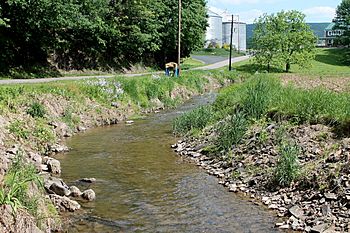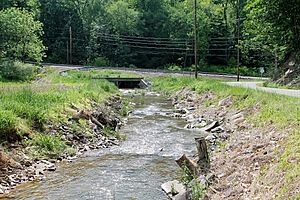Tenmile Run (Susquehanna River tributary) facts for kids
Quick facts for kids Tenmile Run |
|
|---|---|

Tenmile Run in its lower reaches looking upstream
|
|
| Physical characteristics | |
| Main source | Mifflin Township, Columbia County, Pennsylvania |
| River mouth | Susquehanna River in Mifflin Township, Columbia County, Pennsylvania 463 ft (141 m) |
| Length | 6.1 mi (9.8 km) |
| Basin features | |
| Basin size | 8.24 sq mi (21.3 km2) |
Tenmile Run is a small stream in eastern Columbia County, Pennsylvania, USA. It is also known as Ten Mile Run or Ten-mile Run. This stream flows into the Susquehanna River. Tenmile Run is about 6.1 miles (9.8 km) long and is completely located within Mifflin Township.
The area of land that drains into Tenmile Run, called its watershed, covers 8.24 square miles. People first settled here in the late 1700s. Many mills were built along the stream over time. Today, Tenmile Run is known as a great place for coldwater fish, especially wild trout.
Contents
The Stream's Path
Tenmile Run starts in the southern part of Mifflin Township. It begins just north of a place called Nescopeck Mountain. The stream flows towards the west-southwest for a few miles. It moves through a valley that is not very wide or deep.
After a while, the stream turns north. It then enters a much wider valley. As it continues, Tenmile Run moves from the eastern side of this valley to the western side. Here, it crosses Pennsylvania Route 339. The stream then turns west, going around a small hill. Soon after, it turns north again and quickly flows into the Susquehanna River.
Tenmile Run joins the Susquehanna River about 155.53 miles (250.30 km) before the Susquehanna reaches its own mouth.
Land and Water Around Tenmile Run
The watershed of Tenmile Run is the entire area of land where all the rain and snowmelt drain into this stream. This area covers about 8.24 square miles. Where Tenmile Run meets the Susquehanna River, its elevation is 463 feet (141 m) above sea level.
The town of Mifflinville is located close to Tenmile Run. The stream appears on maps made by the United States Geological Survey for Mifflinville and Shumans. There is a small natural ridge that separates the valley of Tenmile Run from another valley nearby. This ridge looks like a fan-shaped pile of sand and gravel. It contains a layer of sand and gravel that is about 60 metres (200 ft) thick.
Tenmile Run's watershed is one of the three main areas that drain water from Columbia County south of the Susquehanna River. The other two are the watersheds of Catawissa Creek and Roaring Creek.
About half of Tenmile Run flows through private land where fishing is not allowed. Another 45 percent is on private land where people can fish. Only 5 percent of the stream is on public land where fishing is open to everyone.
History of Tenmile Run
The name "Tenmile Run" comes from its location. Long ago, it was near a marker that showed "ten miles" on a road leading to Catawissa.
One of the first people to settle in Mifflin Township was Nicholas Angle, who made his home near Tenmile Run. In the late 1700s, families like the Browns, Creasys, and Kirkendalls lived on a ridge overlooking the stream. In 1793, John Brown moved to a large piece of land, about 400 acres, in the stream's valley.
The very first mill in Mifflin Township was built on a smaller stream that flows into Tenmile Run. Jacob Swepenheiser built this mill. Later, in 1869, George Nungesser built a buckwheat mill on Tenmile Run itself. He ran it until 1881, when his son, William J. Nungesser, took over. There was also another buckwheat mill located about a mile north along the stream.
In the past, people also cut down trees, a process called logging, in the area around Tenmile Run.
Life in Tenmile Run
In 2004, the Columbia County Natural Heritage Inventory said Tenmile Run was a "locally significant site." This means it's an important natural area.
You can find Brown trout living in Tenmile Run. The Pennsylvania Department of Environmental Protection has named the stream a "high-quality coldwater fishery." This means the water is clean and cold enough for fish that need those conditions. A 3 miles (4.8 km) section of the stream, from its start down to road T409, is also known as "Class A Wild Trout Waters." This is a special title for streams with healthy populations of wild trout.
Tenmile Run flows through a type of wet forest called a palustrine forest. This forest has both hardwood trees and hemlock trees. The stream's watershed also has shrub swamps. The upper parts of the stream are mostly covered by forests. The lower parts have more swamps and marshes. The trees in these forests include chestnut oak, red maple, red oak, and white ash.
Underneath the main trees, you can find smaller plants like Japanese barberry, low-bush blueberry, witch hazel, may-apple, white baneberry, Virginia creeper, viburnum, striped maple, partridgeberry, dogwood, and spotted wintergreen.
Many different kinds of birds live in the Tenmile Run watershed. This means there is a high level of bird biodiversity. Some of the birds you might see include worm-eating warblers, wood thrushes, ovenbirds, Eastern tufted titmouses, Eastern towhees, veeries, pileated woodpeckers, nuthatches, common yellowthroats, and American redstarts. Other birds found here are scarlet tanagers, black-capped chickadees, and black-throated green warblers.
The forested swamp in the Tenmile Run watershed is home to many plant species. These include skunk cabbage, ferns, prickly sedge, and sphagnum moss. The marshy areas of the watershed have plants like poison sumac, winterberry holly, and multiflora rose.


